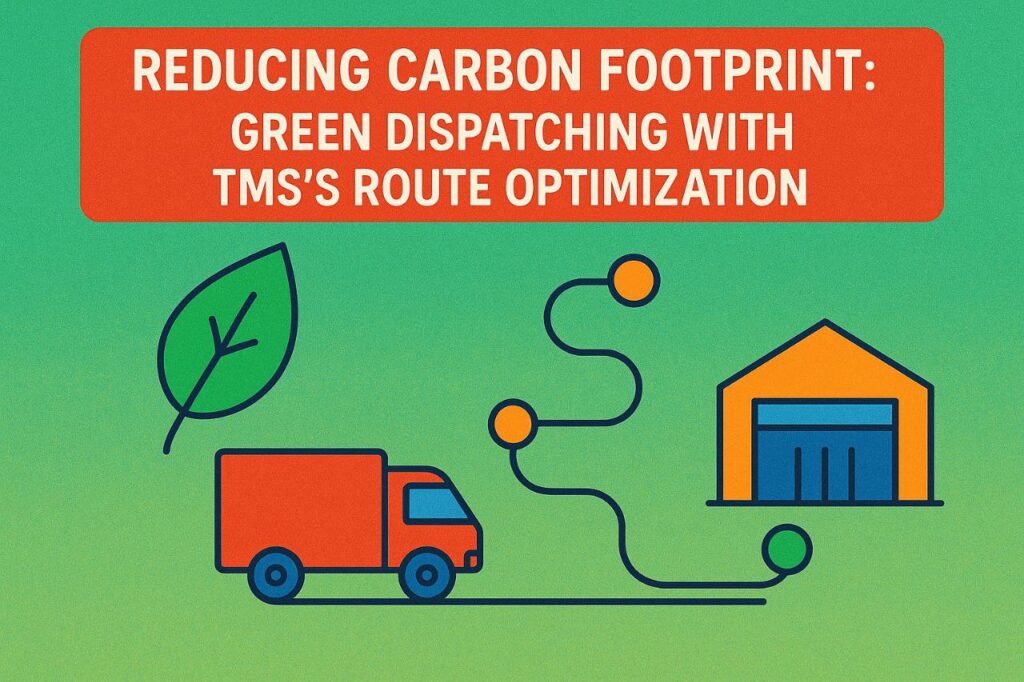Why Carbon Reduction is a Logistics Priority
Sustainability isn’t a “nice-to-have” anymore, it’s a logistics imperative. With rising fuel costs, stricter regulations, and growing customer demand for greener supply chains, reducing carbon emissions has become a strategic priority. As governments enforce stricter emissions targets and customers push for sustainability, logistics teams must adapt.
The key question for today’s fleet managers is: How can we reduce emissions without sacrificing efficiency? The answer lies in smart TMS systems equipped with route optimization tools.
The Carbon Challenge in Modern Freight
The freight industry accounts for nearly 8% of global carbon dioxide emissions, with trucking contributing the most. In 2025, U.S. fleets face tightening EPA regulations, while Europe is tightening carbon trading rules through the “Fit for 55” package. As regulatory pressure rises, fleets and shippers must not only comply with laws but also prove their green logistics efforts to clients and stakeholders.
TMS transportation management systems (TMS) help reduce carbon emissions by optimizing routes, eliminating unnecessary empty miles, and promoting fuel-efficient dispatching.
Read more: How to Prepare Your Logistics Operation for Natural Disasters & Trade Interruptions

Route Optimization as a Green Strategy
Cutting Empty Miles with Smart Dispatching
One of the major contributors to emissions is deadhead miles, the miles trucks run empty. With route optimization tools in TMS systems, fleets can better combine shipments, match loads to capacity, and reduce empty miles. Even a 10% reduction in empty miles can significantly lower emissions and fuel consumption.
Fuel Efficiency and Reduced Idling
Modern TMS platforms leverage congestion metrics, traffic data, and historical stop information to minimize driver wait times. By reducing idle time at docks or during delays, fleets can not only cut fuel costs but also reduce unnecessary CO2 emissions.
Data-Driven Emission Tracking
t’s not enough to just optimize routes, fleets need to measure the results. TMS systems can integrate fuel usage data with routing information to create carbon footprint reports after each trip. This helps logistics teams set realistic sustainability targets and demonstrate measurable progress toward ESG (Environmental, Social, Governance) compliance.
Read more: Real-Time Exception Management: Avoiding Detention Fees with FTM Alerts
Regulatory & Customer Pressures for Sustainability
Stricter regulations are increasing pressure on fleets to meet sustainability goals. From California’s Advanced Clean Fleets rule to the EU’s ETS carbon trading scheme, regulations are pushing fleets to prove their green credentials. At the same time, shippers and retailers are increasingly requiring proof of carbon reduction efforts from their 3PLs.
The competitive advantage lies in fleets that can demonstrate a proven track record of reduced emissions. With TMS route optimization, brokers and shippers can showcase their green logistics while meeting service level agreements and keeping costs competitive.
Read more: TMS Freight Visibility: Enhance Shipment & Carrier Transparency
Quick Wins: Practical Steps for Green Dispatching
Here are five actionable steps to make your fleet more carbon-conscious and cost-efficient:
| Action Step | Why It Works |
|---|---|
| Consolidate Shipments | Reduces the number of trips, cutting both costs and emissions. |
| Prioritize Backhauls | Eliminates empty miles, optimizing load capacity. |
| Integrate Real-Time Traffic Data | Minimizes idling and delays, saving fuel. |
| Set “Carbon Cost” KPIs | Embeds sustainability into daily decisions. |
| Run Quarterly Emission Scorecards | Encourages accountability and highlights high-impact lanes. |
The Case for TMS in Sustainable Freight
Without a modern TMS in trucking or TMS in shipping, it’s impossible to optimize routes effectively. A traditional approach—like spreadsheets—lacks the real-time capabilities of TMS systems that integrate traffic, load, and weather data. TMS platforms offer fleets a clear path toward sustainability and regulatory compliance.
FTM’s TMS transportation software empowers fleets to reduce carbon emissions while still meeting service level agreements. This makes it possible to achieve green logistics goals without sacrificing operational efficiency.
Turning Routing Decisions into Climate Action
In logistics, every mile counts. By adopting green dispatching practices and leveraging TMS route optimization, supply chain leaders can save costs, meet compliance requirements, and lower their carbon footprint, all without compromising on service quality.
Sustainability and profitability no longer compete, they go hand in hand. Smarter dispatching ensures logistics operations can be greener and leaner.
Ready to see how route optimization can make your logistics greener and more efficient?
Book Your FREE Demo today and discover how FTM’s TMS solutions can help you achieve your sustainability goals.
